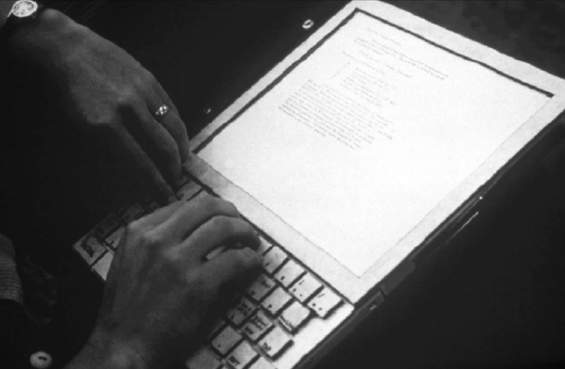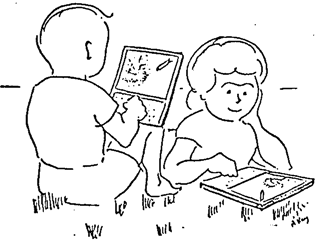What you’re looking at above might seem like an early to mid-90’s predecessor to the iPad, but you might be surprised to learn that the device, called the Dynabook, was conceptualized in 1968 by famed computer scientist Alan Kay. The device was envisioned as an educational tool and was naturally geared towards children, as evidenced by a 1972 research paper titled “A Personal Computer for Children of All Ages” that Kay published while working at the legendary Xerox Palo Alto Research Center.
As a quick aside, if you need any proof about the brilliance and foresight of Alan Kay, then Kay’s research paper is an absolute must read. His thoroughly detailed vision of how consumers might use the Dynabook is eerily similar to how people are using the iPad today. I tried to pick out one passage as an example, but there were literally too many too choose from. And again, Kay’s paper was written nearly 40 years ago!
But back to the Dynabook, a device, that even in concept form, was unbelievably ahead of its time.
Kay’s vision for the Dynabook described a portable notebook sized device capable of displaying text and dynamic graphics with contrast ratios similar to that of a book. The user interface should use “linguistic concepts”, Kay wrote, a brilliant and prophetic turn of phrase in light of the easy to use iPhone OS that even toddlers are capable of figuring out. Kay’s vision for the Dynabook also included the ability to connect to a high bandwidth network, a plasma screen, and remarkably, a virtual keyboard as well.
Suppose the display panel covers the full extent of the notebook surface. Any keyboard arrangement one might wish can then be displayed anywhere on the surface.
That’s essentially the same point Steve Jobs made about the iPhone when he first demoed the device at Macworld 2007.
Finally, Kay envisioned the Dynabook as a device capable of housing “several hours of audio (voice/music) files”, and remarkably, Kay describes a system of downloading books to the device that more or less embodies what the iTunes App Store is today.
And how much did Kay envision charging for this device? $500, which is exactly where Apple priced the base model iPad.
Steve Jobs and Apple have praised the iPad as a revolutionary device, but technological advancements aren’t concocted in a vacuum. Rather, they’re often the amalgamation of varying ideas and technologies of the past. The iPad, for example, is a natural extension of the iPhone OS, whose multitouch technology was acquired by Apple from a company called Fingerworks in 2005. But multitouch technology, along with a host of other features prominent in Apple devices, have roots that stretch back decades. In other words, the technology of today is inextricably tied to the technology of the past.
Kay elaborates in an interview with Tom’s Hardware:
Of course, many things in the multi-touch UI, page turning animations, etc. were first done by the group of my friend Nicholas Negroponte at MIT. The idea of touch screen interaction also goes back to this community, both at PARC and Negroponte’s research group at MIT that invented a multi-touch tablet in the 70s. One set of the machines we made, called ‘The NoteTaker,’ had a touch screen.
Alan Kay, with whom Steve Jobs is still reportedly close, concedes that Jobs has for sometime been aware of his Dynabook idea, a fact which raises the question of whether or not the idea for the iPad can be traced all the way back to the Dynabook itself. Of course, a more cynical Apple observer might argue that Jobs stole the idea for the iPad.
Kay, however, scoffs at the idea that Jobs stole his idea for an iPad-like device, though he acknowledges that the Dynabook was undoubtedly an influence on Jobs and the development of the iPad. To be fair, though, you’d be hard pressed to find a modern computing technology with roots that don’t stretch all the way back to Xerox Parc. That place was a virtual breeding ground for great and transcendent ideas, and you know how Jobs feels about “stealing great ideas.”
In a somewhat famous exchange, after Jobs intro’d the iPhone, Jobs approached Kay (who used to work at Apple in the mid 80’s) and asked him if the device was “good enough to criticize.” Kay responded, “Make the screen at least 5″x8″ and you will rule the world.”
With the iPad, Apple has heeded that advice.
The iPad has the potential to change the way we as a society use and interact with technology, and while Apple deserves credit for bringing the iPad to life, we should at least be aware that the idea for such a device didn’t magically appear on a whiteboard in an Apple boardroom out of thin air.







April 30th, 2010 at 2:36 pm
Is that Charlie Brown in drag?
April 30th, 2010 at 2:45 pm
er… no disrespect to Alan Kay and his great talent and foresight.. but wouldn’t it be Star Trek that we are all paying tribute to?
At the end of the day, dreamers dream and only the ones who make it happen really count… Just as someday when teleportation or time travel become reality… WHo shall we credit those to?
April 30th, 2010 at 2:50 pm
@viralkq
What are you talking about? The Dynabook was conceptualized in 1968, as the article says. The PADD devices from ST:TNG wasn’t seen until two decades or so later. If anything Star Trek got its idea from Dynabook (although it’s definitely been the source of inspiration of many of our gadgets today).
May 1st, 2010 at 12:18 pm
The original Star Trek series, which started in 1966, featured a “Pad” device, as shown in the fourth image on this page:
http://devdaily.com/gadgets/star-trek-ipad-inventor-gene-roddenberry
I don’t know what season that came from, but because the series ended in 1969, it’s likely that filming for the series ended in 1968, and this device preceded the Dynabook.
May 1st, 2010 at 12:50 pm
Regardless of whether or not a pad like device was featured in Star Trek, a well researched paper that defines practical applications and methods of functionality is worlds apart from a scene in an episode of a Sci-Fi series. To use viralkq’s own example, we wouldn’t give credit to Jules Verne for inventing time travel but you might give some to the physicist (I want to say it was Einstein but I’m not sure.) who theorized that traveling forward through time is possible but never traveling backward. Alan Kay is much more than a simple dreamer, don’t be so quick to dismiss him as such.
May 1st, 2010 at 1:21 pm
“If anything Star Trek got its idea from Dynabook (although it’s definitely been the source of inspiration of many of our gadgets today).”
Well, one difference between the Star Trek “pads” and the Dynabook, is no one seemed to type very much or maybe at all. They are closer to the Apple iPad concept than the Dynabook.
May 1st, 2010 at 7:21 pm
I think we can also refer to the pad device that Frank Pool is watch tv on in 2001. Arthur C Clark in his novel “Imperial Earth” the hero carries a ‘pocket sec’ a smart phone before there was even cell phones. So I think we have to give it up to the man who invented the modern commication satelite Arthur C Clark.
May 1st, 2010 at 7:26 pm
The reason Jobs asked Kaye if the iPhone was good enough to criticize is that Kaye’s review of the Mac in 1984 was “it’s the first computer that is good enough to criticize.
Heaping credit on Apple for making iPad doesn’t take anything away from Kaye, who was writing research papers and making cardboard computers in the 1960’s so that people would build them. He is seen as a giant in computing because he was so influential. Heaping credit on him doesn’t take anything away from Apple, either. Nobody ever claimed that iPad started on a whiteboard at Apple. But it’s a long way from cardboard to functioning device, and there are many feature of iPad that weren’t even imagined just a few years ago. The way iPhone OS morphs into various devices like a compass or multitrack recorder is way beyond some text on a screen. To build and ship a device like this worldwide for $499 is also amazing. That’s actually only $99 in 1968 money.
Science fiction also contributes and inspires. The tablet in the original Star Trek was more of a paperless pen/clipboard, though.
May 1st, 2010 at 8:48 pm
he said it was $500. now $500 isn’t worth *as* much.
May 1st, 2010 at 10:10 pm
Alan Kay also developed Smalltalk, a language that he envisioned users, including children, actively programming with. What a tragedy that Mr. Jobs has ignored what is arguably the most important feature of the Dynabook — its ability to be programmed and customized easily by its users.
May 4th, 2010 at 3:57 am
For those who know nothing about Alan Kay, he was instrumental in the development of object oriented systems and the programming language SmallTalk following on from Simula. His work at Xerox PARC on computer workstations following Engelbart and Papert set the scene for the networked computer systems we now all take for granted. Without people like Kay Digg would not exist. You all owe this guy big time.